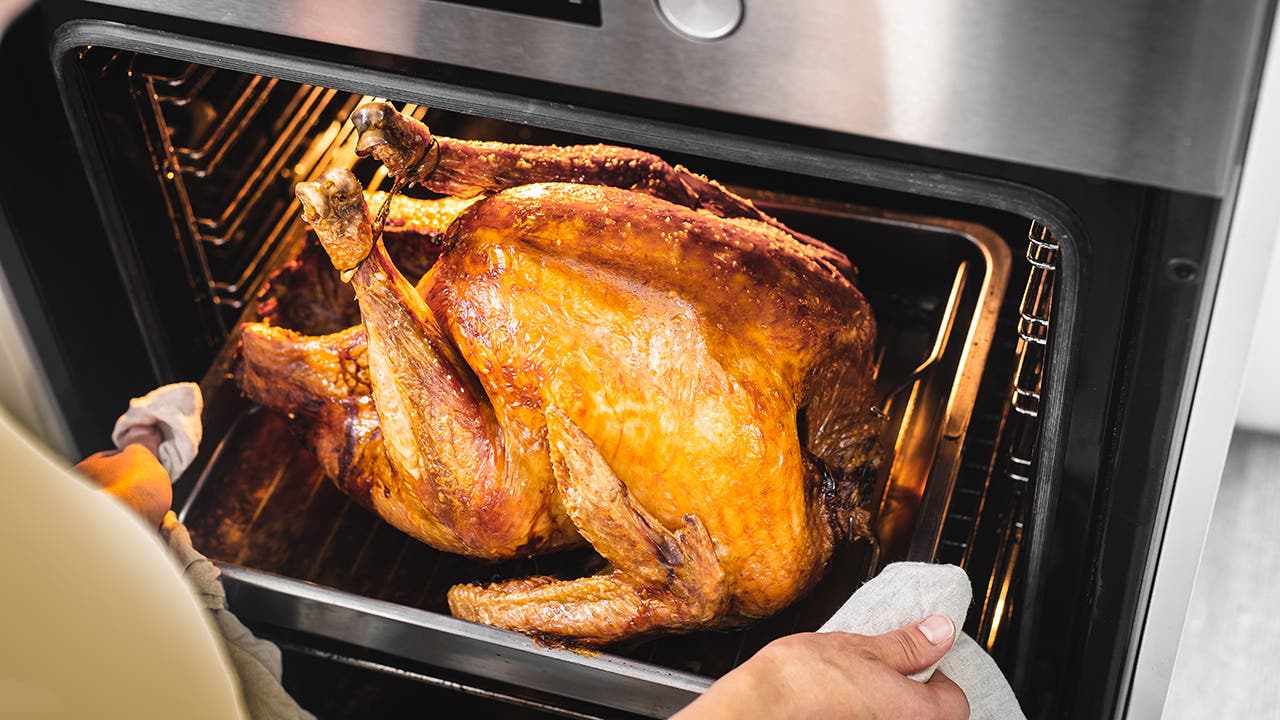Six tips for saving on Thanksgiving costs

The Bankrate promise
At Bankrate we strive to help you make smarter financial decisions. While we adhere to strict , this post may contain references to products from our partners. Here's an explanation for . The content on this page is accurate as of the posting date; however, some of the offers mentioned may have expired. Terms apply to the offers listed on this page. Any opinions, analyses, reviews or recommendations expressed in this article are those of the author’s alone, and have not been reviewed, approved or otherwise endorsed by any card issuer.
Thanksgiving is a favorite holiday of many Americans, especially those who love a good meal and a long weekend. Unfortunately, due in part to rising food costs, many are finding themselves strapped for the cash needed to pull off their Thanksgiving feasts.
How much is a Thanksgiving dinner, on average? According to the Farm Bureau, in 2021, a Thanksgiving meal for ten comes in at about $53. That’s up about 14 percent from 2019. And remember — that’s just dinner. That doesn’t include the drinks, decor, and other expenses associated with hosting.
Here are six tips that can help you do Thanksgiving on a budget, however many people are gathering around your table.
Start your shopping early
Last year, shoppers started gathering their Thanksgiving goods earlier than usual due to food shortages. Though the supply chain has improved, it’s never a bad idea to get ahead. If you don’t want to be running around last minute competing with everyone (and their brother) and likely paying more than you want for your Thanksgiving necessities, start now.
Shopping early doesn’t just ensure you’ll get your pumpkin pie filling. It can also help you save. Since retailers start putting out Thanksgiving staples early, keeping an eye on different companies’ prices can help you find the best deal advertised. If you have flexibility within your menu, you can plan your menu around these deals.
Stick to your list and budget
Taking the time to create a Thanksgiving dinner shopping list and a budget is well worth the money that it can save you — as long as you stick to your plan. If not, you could find yourself buying more food than your guests can eat, causing you to waste food and money.
When creating your shopping list, make sure to account for everything that you will need to entertain your guests, from food to hosting essentials! Some often forgotten expenses include:
- Dinnerware (plates, napkins, glassware, cutlery, etc.)
- Beverages
- Cooking essentials (meat thermometer, roasting pans, etc.)
- Seating for every guest
- Decor and centerpieces
- Storage for leftover food
- Extra utility costs (propane, water, natural gas, etc.)
If you’re going to spend money to host, you might as well be earning credit card rewards on those purchases. The best credit cards can earn hundreds of dollars in cash back each year, and several even offer boosted rates on grocery purchases. Just make sure you have a solid plan in place to pay back your purchases at the end of the month or else the interest you’ll pay will outweigh the rewards you earn.
Watch for grocery sales and coupons
Thanksgiving is an expensive meal to plan for. However, if you do it right, you can save big. For starters, keep an eye on the sale flyers for your local grocery stores. The few weeks leading up to Thanksgiving will likely have the best sales on staples like cranberry sauce, pumpkin pie filling, stuffing and everything else your family loves.
Also, stick to generic products rather than brand names. According to Consumer Reports, these generic, store-brand names cost 20 percent to 25 percent less than brand names. So if you’re not married to a particular name brand, go with the store brand.
Finally, Thanksgiving is the perfect time to take advantage of the price-matching policies companies offer. Target is a great example. They have a list of competitors on their site, and if you find a lower-cost item from one of the stores, Target will refund you the difference. While Walmart is a little stingier on their price-matching, they also have a policy worth checking out.
Have guests pitch in for sides
Although some hosts pride themselves on providing all of the food for Thanksgiving, it isn’t always economical. If your Thanksgiving budget is tight, you may want to consider asking your guests to pitch in by bringing their favorite side dishes to your celebration. Not only will this spread out the cost of dinner across the entire crowd, but it will also help you save time in the kitchen. Plus, you may even help those with food sensitivities and allergies have something at the table to eat.
If you like to stick to tradition, you may want to ask your guests to bring one (or more) of the most popular Thanksgiving sides, according to Google Trends data collected by Newsweek, these are:
- Stuffing
- Macaroni and cheese
- Green bean casserole
- Mashed potatoes
- Dinner rolls
It’s no surprise that stuffing tops the list of sides, with about 40 million boxes of Stove Top stuffing sold between October and December each year. And whatever you do, don’t forget the cranberry sauce! According to OceanSpray, 80 million pounds of cranberries are consumed by Americans during the week of Thanksgiving.
Make use of turkey’s versatility
Turkey is the star of most people’s family Thanksgiving dinner. In fact, Butterball’s Thanksgiving Outlook Report found that 85 percent of those hosting the holiday in 2022 are planning on serving it. However, it does tend to be one of — if not the most — expensive parts of a Thanksgiving meal, and prices are on the rise.
The USDA reports that the average cost of turkey (as of September 30th, 2022) is $1.39 per pound, up slightly from 2021’s average of $1.36 per pound. When you consider that many people buy Thanksgiving turkeys that weigh into the double digits, that can add up to a lot of Thanksgiving turkey money.
One of the best ways to fit turkey into your budget is to use it as the main ingredient in meals after Thanksgiving day and forgo some of your normal food budget. You can turn leftovers into dishes like turkey soup (save the turkey bones for this) or turkey sandwiches. If you have more turkey than you can handle eating, try freezing it for easy meals in the future.
If the price of turkey is out of your budget and you are willing to break with tradition, chicken ($1.28 per pound on average) can be a more economical option.
Plan your travel wisely
If you find yourself traveling for Thanksgiving this year, you’re in good company. A September 2022 survey by Bankrate found that 43 percent of U.S. adults are planning to travel this holiday season. Unfortunately, nearly 8 in 10 of those travelers say inflation and rising prices are forcing them to make adjustments to their plans — like traveling shorter distances or driving instead of flying.
If you need to fly to your Thanksgiving celebration, you can often save some cash by flying on slower travel days. AAA suggests you avoid traveling on the Tuesday or Wednesday before Thanksgiving and stick to Monday instead. As for when to book the flight itself, AAA says about two weeks before Thanksgiving you’ll get the best deals. Do know, however, that waiting until the last minutes does increase the risk of you not being able to get a flight.
The bottom line
Pulling off Thanksgiving on a budget requires preparation. By creating a menu, a budget and a shopping list and planning your travel strategically, you can keep yourself organized and stop yourself from giving in to pricey upsells. In the end, you will find yourself with less stress and a bank account that isn’t feeling a holiday hangover.
Related Articles



